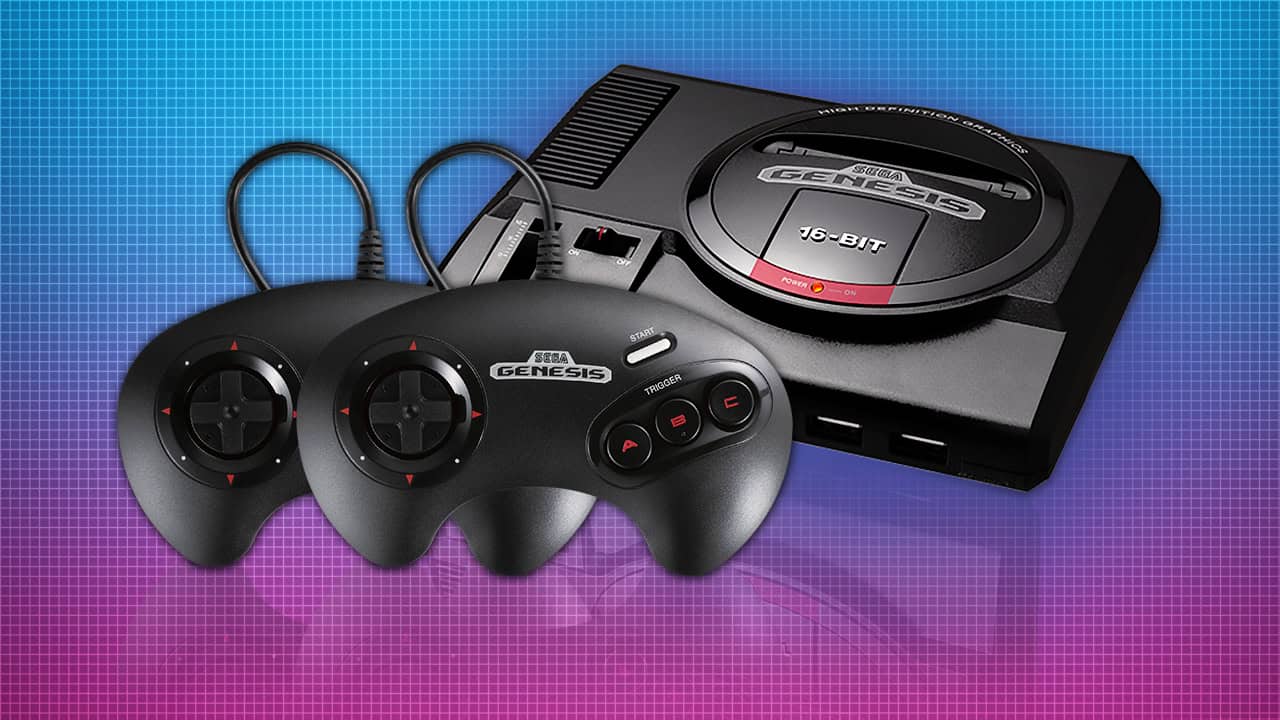Whether you know it as the Mega Drive or the Sega Genesis, legendary arcade publisher Sega’s 16-bit home console is an iconic piece of hardware home to some of the more noteworthy video games of the 4th generation. Following a series of Japan-exclusive home computers (the SG-1000, SG-3000, and SG-1000 Mark II), Sega would break into the North American video game market with the Sega Master System in 1985, the same year that Nintendo would bring the Famicom to the US as the Nintendo Entertainment System. Nintendo would end up being the undisputed winner of the 3rd console generation thanks to the NES’ excellent marketing and a slew of iconic software, but Sega ended up being the first company to get a 16-bit upgrade out the door in the Sega Genesis. And the best Sega Genesis games backed up the company’s claim that “Sega does what Nintendon’t”.
30. Herzog Zwei
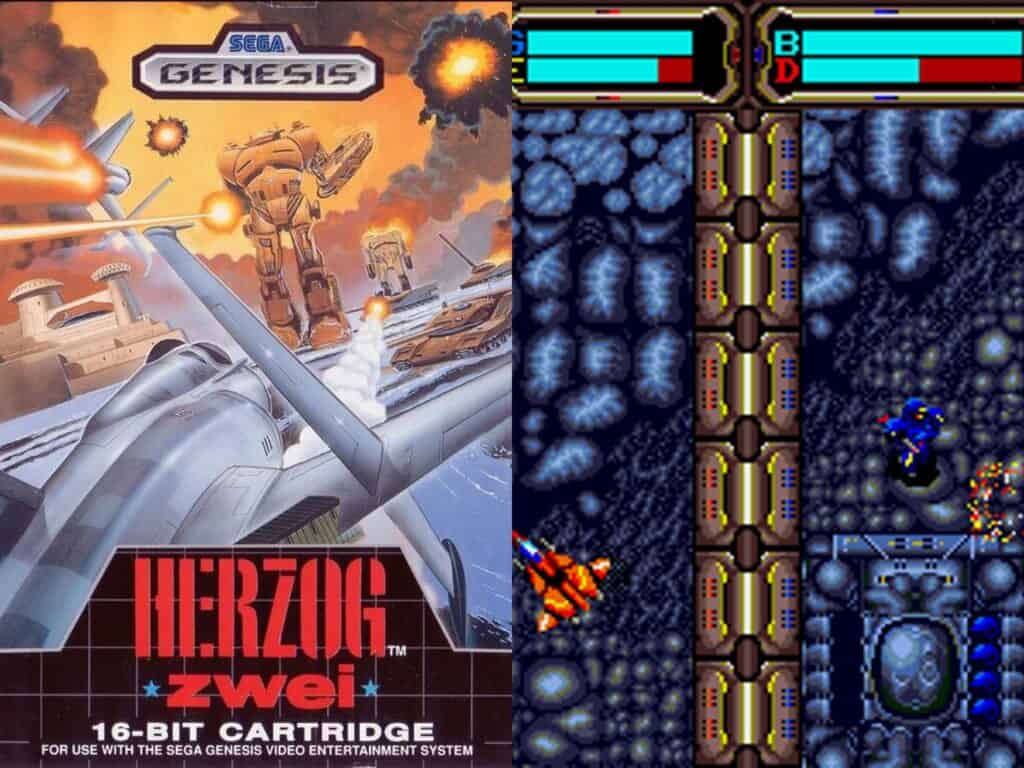
©CheatCC
- Release Date — December 15, 1989
- Publisher/Developer — Sega/Technosoft
- Review Aggregate Score — 82% (Generally Favorable)
Strategy games, particularly those of the Real-Time Strategy (RTS) variety, don’t work all that well on home consoles. Even in the modern era, most RTS fans prefer the more responsive controls and situational awareness afforded by playing on PC using a mouse and keyboard, which makes Herzog Zwei all the more impressive. A blend between a top-down twin-stick shooter/shmup and RTS game, Herzog Zwei has players transform between a ship that can carry units to enemy bases and a mech that can fight the enemy and occupy/control enemy bases. It’s not the most complex RTS game, but the fact that Sega and Technosoft were able to make Herzog Zwei work on the Genesis hardware while using a 3-button control pad is practically a miracle.
29. Gain Ground
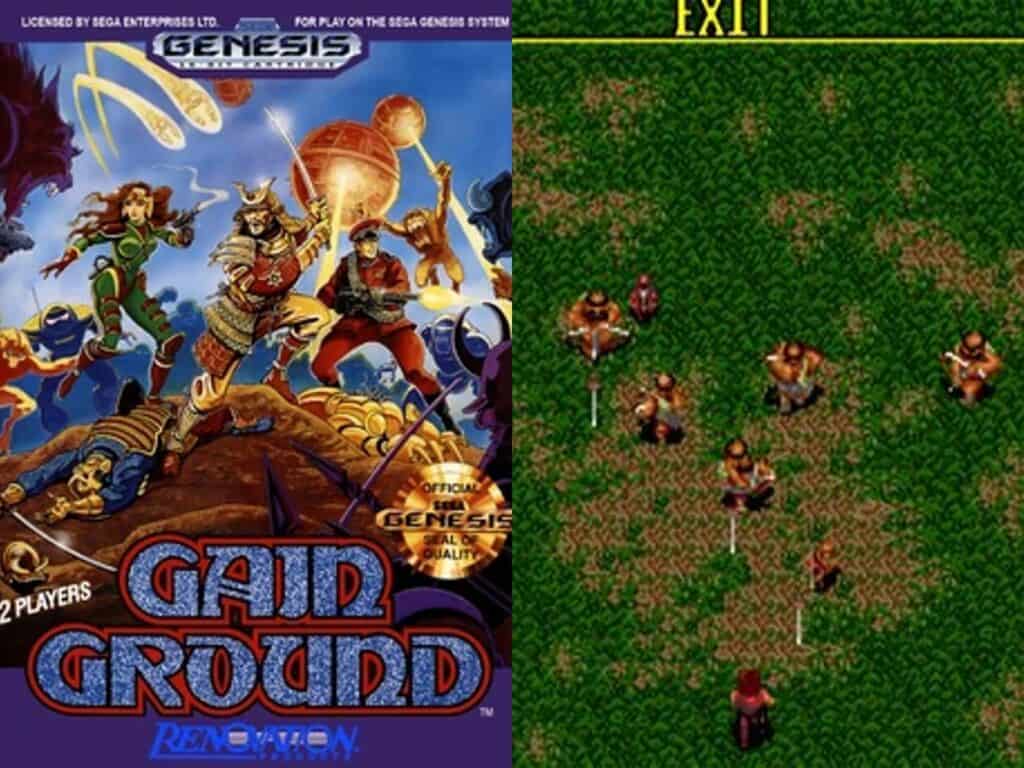
©CheatCC
- Release Date — January 3, 1991
- Publisher/Developer — Sega/Sega, Sanritsu
- Review Aggregate Score — 80% (Generally Favorable)
Sega’s Gain Ground had been a fairly big hit in the arcades, making a 16-bit port to the Sega Genesis all but a guarantee. Surprisingly, the Genesis port of Gain Ground ends up being the definitive version of the game for how well it translates the arcade experience into players’ living rooms. It also happens to be one of the better and more challenging run n’ gun games on the console, and its unique fantasy-themed setting helps to differentiate it from the more commonly seen military sci-fi run n’ gun games of the era like Contra. It may be slightly derivative of Capcom’s Commando, but Gain Ground is practically an essential two-player cart for the Genesis.
28. Teenage Mutant Ninja Turtles: The Hyperstone Heist

©CheatCC
- Release Date — December 11, 1992
- Publisher/Developer — Konami/Konami
- Review Aggregate Score — 89% (Generally Favorable)
Just a few months after SNES owners would get an arcade port of Konami’s excellent Turtles in Time, Genesis players would get their own version of the title in Teenage Mutant Ninja Turtles: The Hyperstone Heist. And sure, while the SNES version of Turtles in Time goes a long way toward making itself the definitive release of Konami’s excellent TMNT-themed beat ’em up, Hyperstone Heist has more than a few tricks up its sleeve that make it just as compelling a port, even if it is the lesser of the two. In particular, Hyperstone Heist is much closer to a pure port of the original arcade cabinet, its stages are longer, and enemies are generally more challenging. And, if that weren’t enough, Hyperstone Heist is the only version of Turtles in Time that includes a dedicated run button for controlling the Turtles.
27. Earthworm Jim

©CheatCC
- Release Date — October 7, 1994
- Publisher/Developer — Playmates Entertainment/Shiny Entertainment
- Review Aggregate Score — 81% (Generally Favorable)
Third-party titles of the 4th console generation would end up becoming notorious for how their SNES and Genesis versions differ from one another, with the consoles even occasionally getting two completely different versions of a title even though they share the same name and publisher. The Genesis would be the first 16-bit console to get the excellent Earthworm Jim, and the version on Sega’s hardware is still the superior experience over its SNES counterpart arriving just a month later. Earthworm Jim is a zany and off-the-wall action platformer that puts its unique titular hero to good use with some excellent level design, tough platforming challenges, and some best-in-genre boss fights. And where the SNES’ brighter color palette might have better served other games, the darker aesthetic of the Genesis version of Earthworm Jim is more appropriate to its art direction.
26. Vectorman
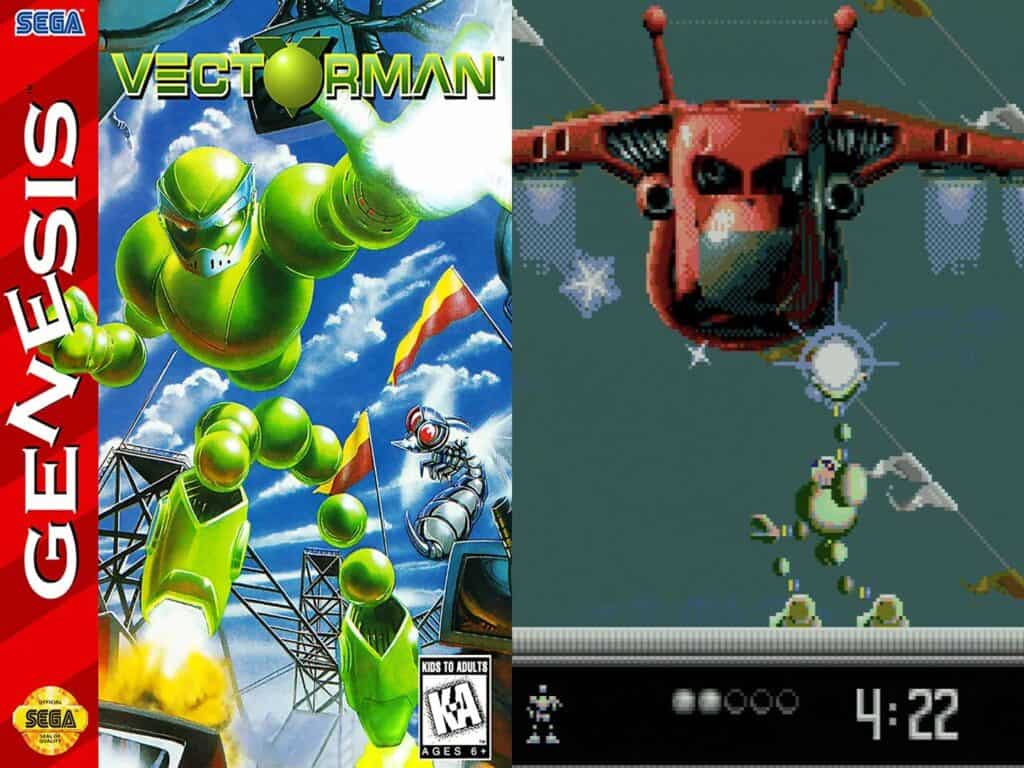
©CheatCC
- Release Date — October 24, 1995
- Publisher/Developer — Sega/BlueSky Software
- Review Aggregate Score — 83% (Generally Favorable)
By October 1995, both Sega and Sony had already brought their next-generation CD-ROM-based consoles to the West in the Saturn and PlayStation, respectively. However, both Sega and Nintendo were far from done supporting their 16-bit hardware, resulting in a slew of impressive titles hoping to bridge the gap between the previous console generation and the next. Like the SNES’ Donkey Kong Country, Sega’s Vectorman is a visually impressive cart that pushes the Genesis to its limits in a thrilling run n’ gun adventure. While Vectorman mostly plays like other similar action platformers (Mega Man, Contra, or even the Genesis’ own Gunstar Heroes), the hero’s ability to transform and use his unique physiology to his advantage sets the game apart from genre contemporaries.
25. Ranger X
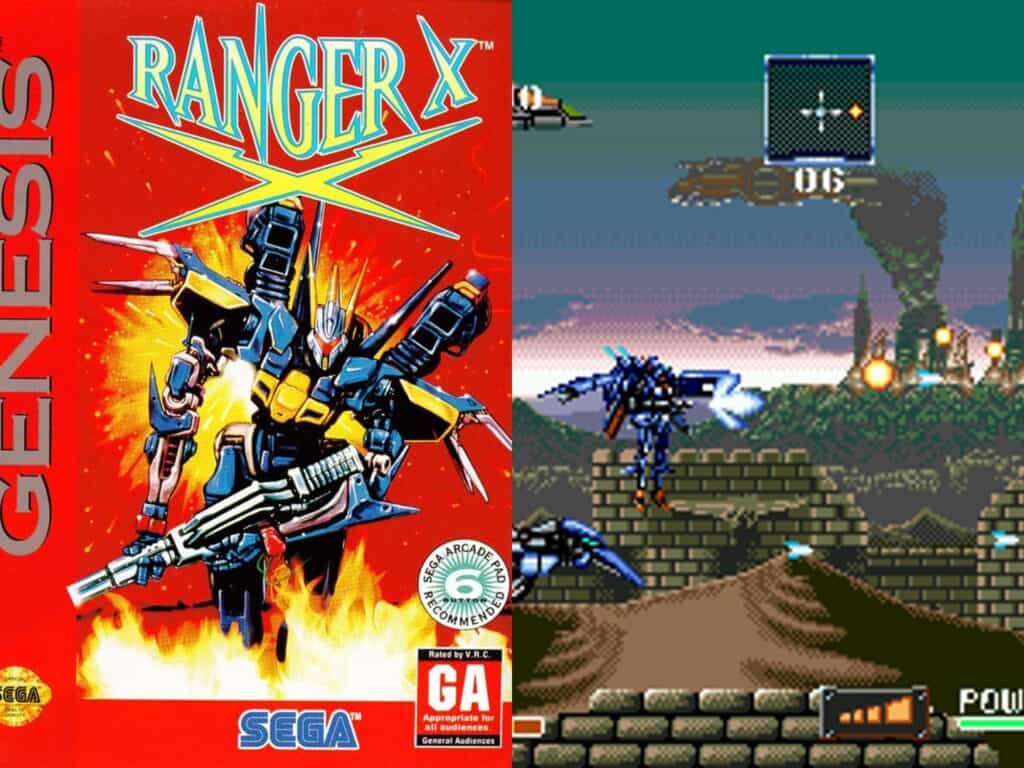
©CheatCC
- Release Date — May 28, 1993
- Publisher/Developer — Sega/GAU Entertainment
- Review Aggregate Score — 84% (Generally Favorable)
One of the Genesis’ hidden gems and a true showpiece for the system’s hardware, Ranger X is an excellent action platformer/Shmup hybrid with a unique control scheme and substantial difficulty. Players control a mech that can either walk or use its rocket pack to jump and hover for short distances along with its smaller sidekick that resembles a car or motorcycle. Separate, each of these mechs can fire their own weapons at enemies approaching from the left or right side of the screen (though some stages incorporate verticality in interesting ways). However, when Ranger X joins up with his smaller companion mech, the two are able to shoot in all 8 directions, including hitting enemies positioned on ceilings or at hard-to-reach angles. Though Ranger X is a fairly difficult game, its unique controls and excellent visuals make it a must-have in the Genesis library.
24. Comix Zone

©CheatCC
- Release Date — August 2, 1995
- Publisher/Developer — Sega/Sega Technical Institute
- Review Aggregate Score — 76% (Generally Favorable)
Both the SNES and Genesis are home to a slew of excellent beat ’em up games, but Comix Zone takes the cake as one of the most unique and one of the more difficult games in the genre. Playing as a comic artist who gets transported into the pages of his own creation, Comix Zone utilizes the comic book format and panel structure to great effect, including some unique transitions between areas of stages and the ability to eject foes into the “gutters” — the industry term for the spaces between panels where readers fill in gaps in the action. That said, Comix Zone is an incredibly hard game that makes other beat ’em ups seem tame by comparison, though that challenge is a welcome change of pace for experienced players.
23. Thunder Force III
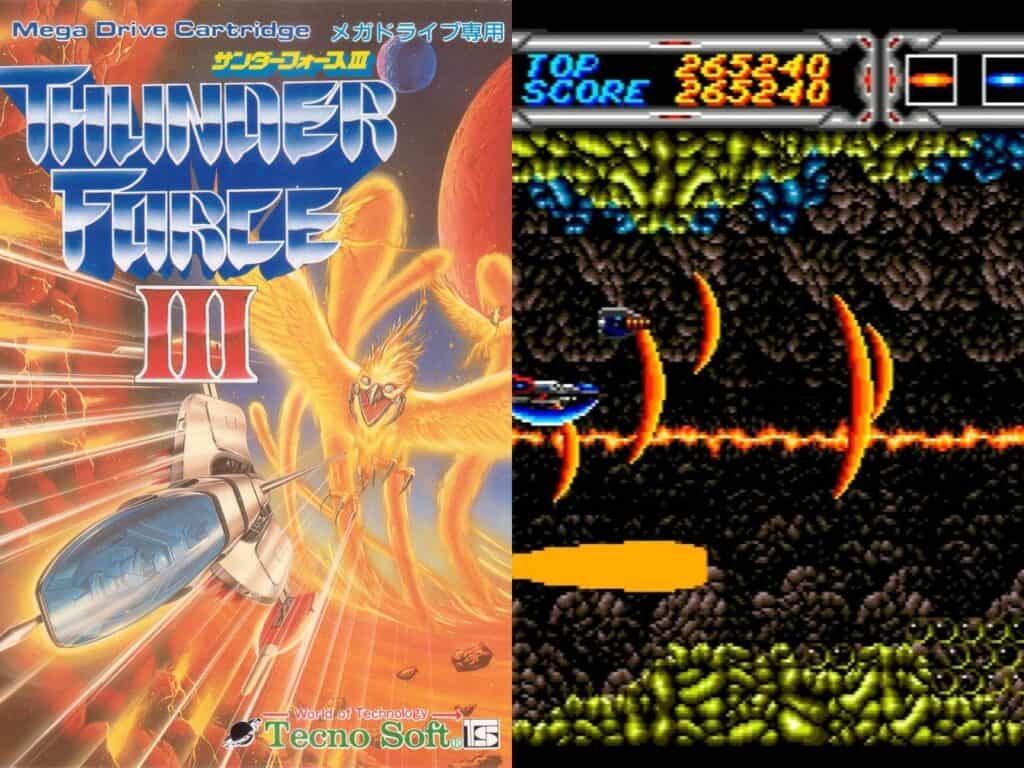
©CheatCC
- Release Date — June 8, 1990
- Publisher/Developer — Technosoft/Technosoft
- Review Aggregate Score — 86% (Generally Favorable)
Commonly accepted as one of the greatest 16-bit Shmups of all time, Thunder Force III would be Technosoft’s magnum opus on the Genesis were it not for its superior sequel. This shoot ’em up game sees players once again take control of the Styx fighter craft from the first two Thunder Force titles, only now all stages adopt the horizontal-scrolling format rather than including the overhead stages from the first two games in the series. Thunder Force III‘s definitive quality is its speed, which shuttles players through its beautifully designed stages at a breakneck pace and never lets up. The ability to switch weapons on the fly and utilize the series’ signature backward-facing shot each come in handy but do little to take away from the immense challenge that Thunder Force III provides.
22. Contra: Hard Corps

©CheatCC
- Release Date — September 15, 1994
- Publisher/Developer — Konami/Konami
- Review Aggregate Score — 77% (Generally Favorable)
Rather than port the excellent Contra III: The Alien Wars to the Sega Genesis, Konami would deliver the completely original and excellent Contra: Hard Corps to the console. Instead of series heroes Bill and Lance, players have a choice between one of four different rag-tag heroes positioned as the Contra division’s Hard Corps unit — super tough super soldiers capable of handling even the toughest assignments. Hard Corps (a clever play on “hardcore”) is an apt name, as it might be the most difficultof all the Contra titles. That said, the excellent level design, inventive and challenging boss encounters, and unique abilities of its various protagonists make Contra: Hard Corps an essential entry in the franchise, regardless of its nigh-impossible difficulty.
21. Rocket Knight Adventures

©CheatCC
- Release Date — August 6, 1993
- Publisher/Developer — Konami/Konami
- Review Aggregate Score — 90% (Universal Acclaim)
Konami’s Rocket Knight Adventures would get a sequel on the SNES as Sparkster, but the Genesis original is by far the superior entry in this somewhat overlooked action platformer series. As the opossum knight Sparkster, players make their way through some cleverly designed platforming stages interspersed with surprisingly excellent horizontally-scrolling shmup stages, making Rocket Knight Adventures not all that dissimilar from a blend between Sonic the Hedgehog and Gradius. Sparkster’s tail gives him the ability to latch onto tree branches and use them as ledges to swing from or makeshift zip lines, and the jet pack that players can charge up is as useful in combat as it is in traversal. Thanks to its accessible difficulty and excellent visuals, Rocket Knight Adventures is an essential action platformer in the Genesis catalog.
20. Disney’s Aladdin

©CheatCC
- Release Date — November 11, 1993
- Publisher/Developer — Sega/Virgin Games USA
- Review Aggregate Score — 89% (Generally Favorable)
The Genesis versions of games based on Disney licenses are each the superior versions of these titles over their SNES counterparts thanks to their development at the hands of Virgin Games USA, and the best of the bunch is Aladdin. Not only does the Genesis version of Aladdin feature completely different stages from the SNES counterpart, but its visuals and soundtrack are a massive step up from the version arriving on Nintendo’s console. The Lion King and The Jungle Book are both excellent action platformer titles that could have ended up on this list, but the top-notch presentation and excellent stages of Aladdin (especially that thrilling magic carpet escape) make it the definitive Disney game on the Genesis.
19. Phantasy Star III: Generations of Doom
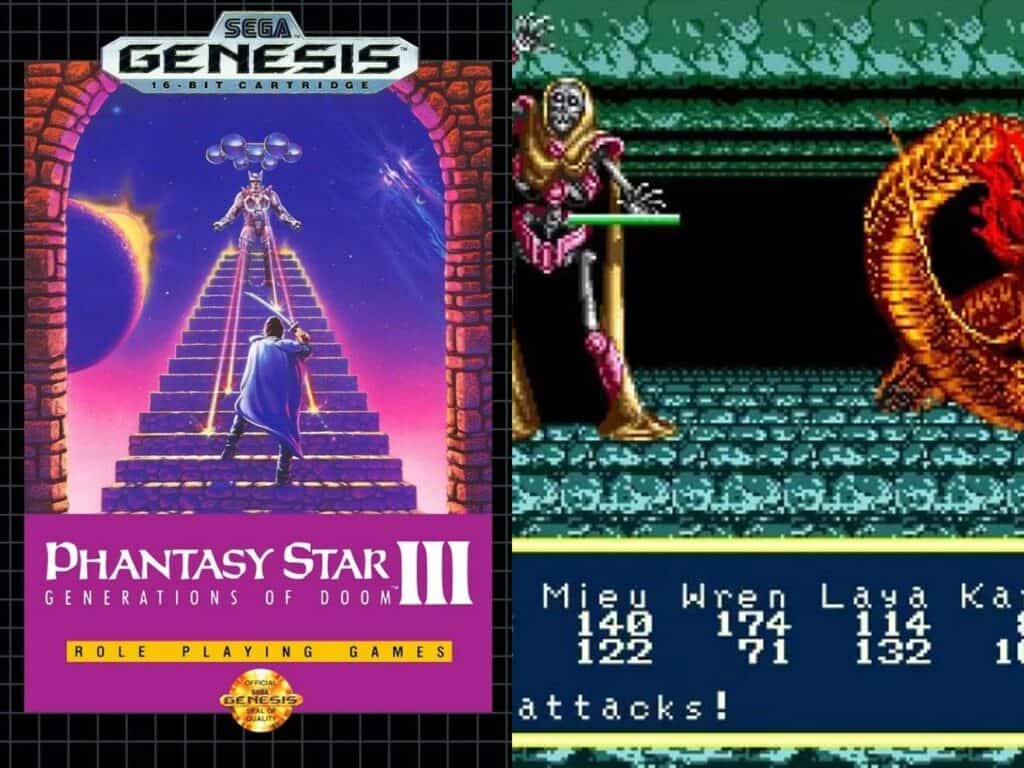
©CheatCC
- Release Date — April 21, 1990
- Publisher/Developer — Sega/Sega
- Review Aggregate Score — 68% (Mixed or Average)
Even though the SNES would end up being the definitive home for console RPGs during the 4th generation (thanks to some legendary titles from Square, Enix, and Capcom), the Genesis would have its own slew of excellent first-party titles in the genre. Principal among these is the Phantasy Star series, Sega’s first-party traditional JRPG franchise that borrows heavily from the general template of Dragon Quest but utilizes an excellent sci-fi-meets-fantasy setting. The first two Phantasy Star games are each noteworthy titles that are important in the general development of the JRPG subgenre, but Phantasy Star III represents a massive leap in quality that sees the series stand toe-to-toe with both Enix’s flagship franchise and Square’s Final Fantasy in terms of its storytelling, gameplay, and presentation.
18. M.U.S.H.A

©CheatCC
- Release Date — December 21, 1990
- Publisher/Developer — Seismic/Compile
- Review Aggregate Score — 73% (Mixed or Average)
A spin-off of Compile’s Aleste series originally intended to be a direct sequel, M.U.S.H.A. is now a legendary Shmup in its own right thanks to some excellent visuals, a best-in-genre soundtrack, and some pitch-perfect gameplay. Players control a mech in M.U.S.H.A. rather than a ship, which doesn’t really change the gameplay all that much but does look incredibly cool. Despite it not doing much to differentiate itself from other games of the era (or even other titles developed by Compile), M.U.S.H.A. is yet another excellent Shmup in the Genesis library that has its own cult following and is much more accessible than any of the Thunder Force games.
17. Golden Axe II

©CheatCC
- Release Date — December 27, 1991
- Publisher/Developer — Sega/Sega
- Review Aggregate Score — 66% (Mixed or Average)
There would end up being three Golden Axe games on the Genesis, but it’s the first sequel and series’ middle entry Golden Axe II that goes down as the definitive fantasy-themed beat ’em up on the console. Once again players get to pick their choice of different characters, each of which has their own strengths and weaknesses according to fantasy hero archetypes. However, Golden Axe II excels over both its predecessor and its sequel in its presentation and performance, providing players with an experience that is faster and smoother than the original and feels more polished than the third game in the series. If you’re going to play just one game in the Golden Axe series, make it the second one.
16. Beyond Oasis

©CheatCC
- Release Date — December 9, 1994
- Publisher/Developer — Sega/Ancient
- Review Aggregate Score — 81% (Generally Favorable)
As far as action RPGs go, you’d be hard-pressed to find a Genesis title that nails the genre more than Beyond Oasis. Known as The Story of Thor in Japan, Beyond Oasis sees players controlling the young Prince Ali after he discovers a magical amulet that grants him powers based on each of the four elements. Beyond Oasis shares more than a little in common with The Legend of Zelda and similar top-down ARPGs, but its unique Middle Eastern setting and excellent visuals and animations give it a unique identity among other games in the genre.
15. ToeJam & Earl

©CheatCC
- Release Date — October 15, 1991
- Publisher/Developer — Sega/Johnson Voorsanger Productions
- Review Aggregate Score — 90% (Universal Acclaim)
Few games are as essential to the Genesis’ intangible attitude and aesthetic as Toejam & Earl. This funky maze platformer has a default two-player mode with each player controlling one-half of the game’s dynamic (and funky) duo, to the point where playing the game in single-player as a solo experience feels like missing out on half the fun. Though its premise is fairly simple (navigate through a single-level maze, find the magic elevator, move on to the next maze, repeat), the visuals and audio of Toejam & Earl, as well as its incomparable style, make it just as important to the Genesis as Sonic the Hedgehog.
14. Crusader of Centy

©CheatCC
- Release Date — June 17, 1994
- Publisher/Developer — Atlus/Nextech
- Review Aggregate Score — 81% (Generally Favorable)
While Beyond Oasis might have borrowed from a wide variety of action RPGs including The Legend of Zelda, Crusader of Centy is about as close as Genesis owners would get to their very own Legend of Zelda clone. That said, Nextech understood the assignment, delivering a quality title that borrows just enough from The Legend of Zelda to not be a shameless imitation while simultaneously understanding the core elements of that series that make it so special. From its visuals and presentation to its excellent combat, dungeons, and puzzle-solving, Crusader of Centy is a worthy substitute for Genesis owners who didn’t have access to an SNES and a copy of A Link to the Past.
13. NHL ’94

©CheatCC
- Release Date — September 11, 1993
- Publisher/Developer — EA Sports/High Score Productions
- Review Aggregate Score — 92% (Universal Acclaim)
Affectionately simply referred to as “Chel” by those who grew up with the title, NHL ’94 on the Genesis is still perhaps the greatest hockey simulation of all time. Even in the face of newer hockey games with photorealistic visuals and more accurate simulations of the “coolest game on Earth”, NHL ’94 reigns supreme thanks to its easy “pick up and play” nature and its phenomenal two-player exhibition matches. The Genesis’ three-button controller makes for a practically fool-proof and perfectly accessible control scheme, and the visuals hold up surprisingly well for a sports game more than 30 years old at this point.
12. X-Men 2: Clone Wars

©CheatCC
- Release Date — February 3, 1995
- Publisher/Developer — Sega/Headgames
- Review Aggregate Score — 70% (Mixed or Average)
Regardless of its somewhat middling critical score, X-Men 2: Clone Wars is the definitive licensed title featuring Marvel’s mutant heroes. The first X-Men game was a great action platformer with some surprisingly challenging difficulty, but the sequel tones down the challenge, adds some new playable heroes (including none other than Magneto himself), and borrows from one of the better then-current comic storylines (the Phalanx saga) to deliver the superior experience. Even Capcom’s excellent X-Men: Mutant Apocalypse on the SNES can’t compare to the action-platforming bliss of X-Men 2: Clone Wars.
11. Lightening Force/Thunder Force IV

©CheatCC
- Release Date — July 24, 1992
- Publisher/Developer — Sega/Technosoft
- Review Aggregate Score — 84% (Generally Favorable)
Both the best Shmup on the Genesis and a strong contender for the greatest 16-bit Shmup of all time, Lightening Force (aka Thunder Force IV) takes everything great about the first three games in Technosoft’s series and combines them into one of the most visually impressive and nail-bitingly difficult games in the genre. Lightning Force is blindingly fast and frantic, yet it never overwhelms the player despite threatening to at almost every moment. Instead, the game is an audiovisual tour-de-force that makes great use of the Genesis’ hardware. The fourth Thunder Force game is also slightly more accessible than its immediate predecessor, and the ability to select stages in a player-preferred order means that you can customize each playthrough to your liking.
10. Shinobi III: Return of the Ninja Master

©CheatCC
- Release Date — July 23, 1993
- Publisher/Developer — Sega/Sega
- Review Aggregate Score — 85% (Generally Favorable)
Sega would end up saving the best game in the Shinobi series for the franchise’s final entry on the Genesis, taking the general format of The Revenge of Shinobi and improving it through more accessible difficulty and improved presentation. Shinobi III is a master class in action platformer design, separating itself from competitors like Ninja Gaiden through its twin emphases on melee and ranged combat and a greater platforming focus. Where Ninja Gaiden forces players to memorize patterns and get into a particular rhythm with enemy spawn points, Shinobi III is all about speed and momentum, creating a frantic experience that really puts the “action” in action platformer.
9. Road Rash 3

©CheatCC
- Release Date — March 1, 1995
- Publisher/Developer — Electronic Arts/Electronic Arts
- Review Aggregate Score — 80% (Generally Favorable)
Electronic Arts’ excellent Road Rash series would end up being one of the publisher’s greatest Genesis-exclusive franchises, and the third entry is undoubtedly its best. Like previous games in the series, players race competitors on motorcycles and use weapons to sabotage them and knock them off their bikes. Road Rash 3 ends up being the best in the series thanks to its sense of speed, excellent soundtrack, a wide variety of offensive options, and satisfying progression loop of racing for money and using those earnings to purchase better bikes and stronger weapons.
8. Landstalker

©CheatCC
- Release Date — October 20, 1992
- Publisher/Developer — Sega/Climax Entertainment
- Review Aggregate Score — 87% (Generally Favorable)
An action RPG from the same developer who would assist Sega with the Shining Force series, Landstalker is a phenomenal title that bears more than a passing resemblance to the cult-classic Alundra. In fact, after Landstalker‘s release, several of the key team members from Climax Entertainment would form Matrix Software, Alundra‘s developer, making Landstalker almost like a spiritual predecessor. Regardless, Landstalker‘s isometric perspective helps it to stand out from other action RPGs of the era (which traditionally favored the top-down perspective of The Legend of Zelda), and its combat and puzzle-solving fit nicely within its RPG systems and mechanics.
7. Shining Force II

©CheatCC
- Release Date — October 1, 1993
- Publisher/Developer — Sega/Sonic! Software Planning
- Review Aggregate Score — 89% (Generally Favorable)
While SNES owners would miss out on the Fire Emblem games that were exclusive to the Super Famicom, Western gamers would have the phenomenal Shining Force for their tactical RPG fix on the Genesis. The first Shining Force is an excellent game, but Shining Force II is the better entry in the series for doing everything that the first game does, but better. The title sits right alongside the SNES’ Ogre Battle: The March of the Black Queen as one of the definitive titles in the TRPG/SRPG subgenre of the 16-bit era and is arguably one of the greatest RPGs on Sega’s 4th generation console.
6. Sonic 3/Sonic & Knuckles

©CheatCC
- Release Date — February 2, 1994
- Publisher/Developer — Sega/Sega Technical Institute
- Review Aggregate Score — 94% (Universal Acclaim)
The third Sonic game is an excellent title on its own, but its place in the Genesis library is enhanced when combined with the unique Sonic & Knuckles cart. As a standalone game, Sonic & Knuckles is a nice companion title to Sonic 3, but together the two become one of the final great 16-bit platformers and an important part of the Genesis’ history as an innovator. Introducing Knuckles into Sonic 2 was a novelty made possible by the connector cart for Sonic & Knuckles, but the anti-hero actually felt at home in Sonic 3, making playing one or the other (either Sonic & Knuckles or Sonic 3) feel like an incomplete experience. Together, though, Sonic 3 and Sonic & Knuckles represent Sega’s mascot at his peak.
5. Castlevania: Bloodlines

©CheatCC
- Release Date — March 17, 1994
- Publisher/Developer — Konami/Konami
- Review Aggregate Score — 84% (Generally Favorable)
Castlevania: Bloodlines is an interesting entry in Konami’s long-running action series in that it features an entirely different hero from the rest of the series (switching out Simon Belmont for newcomers John Morris and Eric Lecarde) and takes place during the more contemporary Industrial Revolution. Ultimately, though, Bloodlines is more of the excellent action-platforming gameplay players had come to expect from the series. The game’s development specifically for the Genesis resulted in it taking great advantage of Sega’s hardware. And like Contra: Hard Corps, Bloodlines is notorious for being one of the more difficult games in the series, especially in comparison to the SNES’ more forgiving Super Castlevania IV.
4. Streets of Rage 2

©CheatCC
- Release Date — December 15, 1992
- Publisher/Developer — Sega/Sega
- Review Aggregate Score — 90% (Universal Acclaim)
The greatest beat ’em up on the Sega Genesis is none other than Sega’s Streets of Rage 2, outdoing both its predecessor and its sequel to stand as the definitive entry in the franchise. Each of the 4 playable heroes in Streets of Rage 2 have their own strengths and weaknesses making them viable combatants, and they also each fulfill a more traditional beat ’em up archetype before the series inevitably went a bit off the rails in Streets of Rage 3. Most importantly, though, Streets of Rage 2 is almost perfectly balanced and has some incredibly deep combat mechanics despite it also being a perfectly accessible game for genre newcomers.
3. Phantasy Star IV

©CheatCC
- Release Date — December 17, 1993
- Publisher/Developer — Sega/Sega
- Review Aggregate Score — 87% (Generally Favorable)
The greatest RPG on the Genesis also happens to be the final entry in the long-running Phantasy Star saga, seeing the franchise come full circle to deliver on the epic adventure that began 6 years prior in 1987. Aside from Phantasy Star IV really sticking the landing and delivering a satisfying narrative conclusion, though, it also brings about the most pronounced refinements to the franchise’s combat, visuals, and RPG systems. Principal among these are the Chrono Trigger-style combination attacks between party members that make strategic party composition a necessity.
2. Gunstar Heroes

©CheatCC
- Release Date — September 10, 1993
- Publisher/Developer — Sega/Treasure
- Review Aggregate Score — 86% (Generally Favorable)
Treasure’s Gunstar Heroes is one of those genre-defining titles that transcends its original release to become one of the commonly accepted greatest games ever made. While it might not appear that different from similar games like Contra at first glance, Gunstar Heroes‘ signature quality is its over-the-top action and nonstop flood of enemies clogging the screen. Bosses are absolutely massive, imposing foes that take up almost the entire screen, each of the game’s 4 shot types can be further combined to create new combo weapons, and the two-player mode takes the insanity of the solo experience and ratchets it up to 11. An all-time classic in the run n’ gun genre and the greatest Genesis game outside of a certain first-party Sega title…
1. Sonic the Hedgehog 2

©CheatCC
- Release Date — November 21, 1992
- Publisher/Developer — Sega/Sega Technical Institute
- Review Aggregate Score — 90% (Universal Acclaim)
The Sega Genesis had been on the market in the West for three full years before the arrival of Sonic the Hedgehog 2, but that sequel’s release (combined with its place as a pack-in title for the mid-gen hardware redesign of the Sega Genesis) would elevate the console to be neck-and-neck with Nintendo’s SNES. Sonic the Hedgehog 2 was a platforming game like Super Mario World, but it was also simultaneously nothing like Super Mario World. Sonic 2‘s visuals and performance are what most players were drawn in by, but its pitch-perfect platforming, momentum, and sense of speed are what cement the title as one of the most important games in the Sonic franchise and a pivotal release for the Sega Genesis.
The image featured at the top of this post is ©Sega Genesis hardware.
